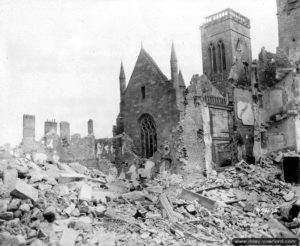Vire (Calvados)
The cities of Normandy during the 1944 battles

- Liberation: 7 August 1944
- Deployed units:
![]() 116th Infantry Regiment, 29th Infantry Division
116th Infantry Regiment, 29th Infantry Division
![]() Combat Command A, 2nd Armored Division
Combat Command A, 2nd Armored Division
![]() 3. Fallschirmjäger-Division
3. Fallschirmjäger-Division
![]() Kampfgruppe Malhmann, 353. Infanterie-Division
Kampfgruppe Malhmann, 353. Infanterie-Division
![]() Kampfgruppe Dettling, 363. Infanterie-Division
Kampfgruppe Dettling, 363. Infanterie-Division
- History:
On the eve of World War II, the town of Vire had a population of nearly 8,000. This commune was a major road junction in the southern Calvados region, bordering the Manche department, connecting the region’s major cities.
On June 6, 1944, the Allies bombed the main towns of Normandy in an effort to slow the advance of German reinforcements heading toward the coast. The town of Vire was not spared: at 8:00 p.m., 24 American B-24 Liberator bombers from the 8th Air Force began the first raid, followed at 2:00 a.m. by 167 aircraft from the Royal Air Force. More than 350 Normans died during this terrible bombardment, which destroyed 95% of the homes and injured nearly 1,500.
The liberation of the ruins of Vire, however, had to wait until August. The U.S. 5th Corps managed to push back the paratroopers of the 3rd Fallschirmjäger Division to the northwest outskirts of the city by August 5, thanks to the constant pressure exerted by Combat Command A of the 2nd Armored Division. But the tanks were blocked near Martilly, the bridge over the Vire River having been destroyed. The Germans took advantage of this to consolidate the defenses in the sector, particularly by leveraging ground movements south of the city center. They were reinforced by a combined arms battle group under the command of Generalleutnant Paul Malhmann, composed of troops belonging to the 353rd Infantry Division, as well as elements of the 363rd Infantry Division.
The next day at 7:15 p.m., the 116th Infantry Regiment (IR) of the 29th Infantry Division resumed the action from the heights west of Vire (hill 219): the infantrymen commanded by Colonel Philip R. Dwyer engaged along this wooded terrain movement which descended steeply towards the river. Supported by heavy fire, the 2nd and 3rd battalions crossed the river then climbed the slope of the opposite bank to reach the first ruined houses. The Germans were surprised by an assault at the end of the day and proved incapable of preventing the risky crossing of the Vire by their adversary. The succession of ground movements prevented the application of precise indirect fire, the Americans thus managed to engage permanently in the town. However, the situation of the 116th Infantry Regiment was critical: the crossing of the Vire River had disorganized the assault troops, and many platoon and squad leaders had lost contact with their subordinates. Similar to what the regiment had experienced at Omaha Beach on June 6, its soldiers regrouped as the fighting and initiatives took hold. At 10:00 p.m., the town center was reached after a lengthy reconnaissance, house by house, despite the absence of armored vehicles.
On August 7, Colonel Dwyer ordered two new offensives: the 1st Battalion advanced towards the lock, but the Germans, relying on solid positions entrenched from the heights of Saint-Clair, managed to stop it. The other action, entrusted to the 2nd Battalion, was directed towards the southeast to seize Hill 251: here again, artillery barrages broke the American assaults: in the evening, the 116th IR held the ruins of the city center and the station district. At nightfall and despite the incessant artillery bombardment, the Americans infiltrated through the German lines to seize the Saint-Clair lock: they reconnoitered several assault routes and waited for the first light of day on August 8 to relaunch the offensive. At 5 a.m., they resumed the advance and immediately invested the defenders’ positions. Surprised but also exhausted after more than three days and nights of intense fighting to defend Vire, the Germans were unable to hold Hill 203 any longer: despite a final struggle, they withdrew towards the south-east at 4:30 p.m., abandoning the town to the Americans.
Vire map:
![]() Back to the Normandy cities in 1944
Back to the Normandy cities in 1944
